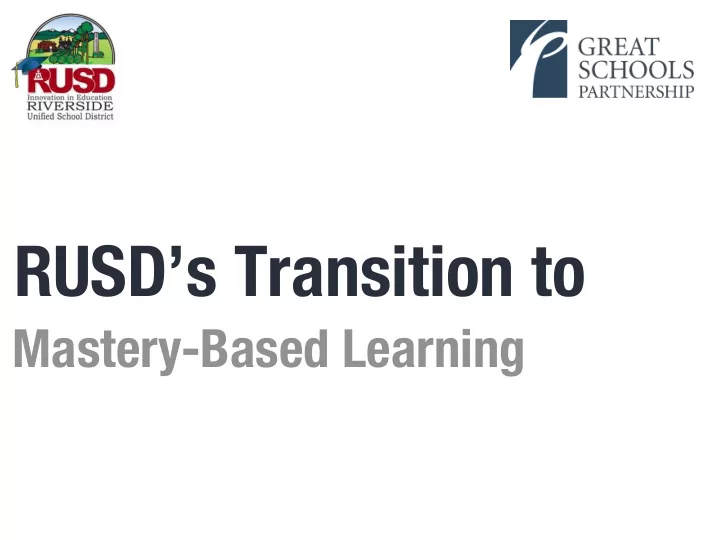

RUSD’s Transition to Mastery-Based Learning
-This is not necessarily new thinking or new work, but rather in many cases a refinement and alignment of already existing practices. -How can we build on the collective wisdom and positive experiences of the district -This is an important message in order to help colleagues know this is not necessarily an add on
What is Mastery Based Learning?
The answer to this question can be found in RUSD’s Guide for Instructional Design
Step one in the guide is defining the desired outcomes for our students. Specialists and staff developers have been working on the drafts of the competencies and indicators.
RUSD’s Key Principles of Mastery Based Learning • All stakeholders are clear about what students are to learn, be able to do, and be like . • All four domains of the Portrait of a Graduate (know, act, think, and be) are equally important but graded and reported separately. • Assessment exists to provide feedback and gauge mastery of RUSD graduation competencies and performance indicators.
These principles are embedded in the guide
Foundational Expectations All students are expected to achieve mastery in every competency and all of the elements of the RUSD Portrait of a Graduate.
Foundational Expectations Educators in RUSD share the assumption and belief that all students can be successful and demonstrate mastery in each of the graduation competencies
These are some foundational expectations that are outlined in The Guide
Mastery is a student’s ability to transfer learning in and/or across content areas.
Why? • Ensuring equity in outcomes • This is Step 1 of the Instructional Guide - defining mastery • Defines the “Line of Sameness” in a district where choice is valued and promoted • Wide body of researching spanning decades supports RUSD’s key principles of Mastery Based Learning
This speaks to our desire and goal of equity We must hold all students to the same standard and turn our energies to helping them all achieve mastery.
How? • Committee created the Portrait of a Graduate • Policy Alignment • ISSs and SDs, with GSP, are in the process of drafting • Graduation competencies • Performance indicators • Scoring Criteria
These are the early steps in this work. It began with the development of P.O.G The next step is to agree on clearly defined outcomes for our students Next, we must set the appropriate policy landscape in our district to support this work and draft a set of common scoring criteria to ensure we are holding all students to the same standard. We will clearly define what we mean by mastery
A Graduation Competency Is... a standard that focuses instruction on the most foundational, enduring, and leveraged concepts and skills within a discipline.
A Performance Indicator The aggregation of mastery on these performance indicators measures whether a student has met the graduation standard.
A Performance Indicator Describes or defines what students need to know and be able to do to demonstrate mastery of a graduation competency.
A Performance Indicator Students can demonstrate their performance over time.
A Performance Indicator Students can demonstrate their performance over time.
A Performance Indicator Is measurable
Who and When? • Last Year - 2 small groups • This year - ISSs and SDs, principals, teachers • Timeline - end this year with grade 12 • Future work - benchmark grades, then all grades • Development of scoring criteria • RUSD will validate draft timeline
What does this mean to me? • Anything I have to do? • Anything I have to learn? • How does it connect to what I am doing now? • If we already have standards, why do we need competencies and how do they go together?
The answers to these questions can come from the Ed Services
From Competencies to Units Competencies Performance Indicators Reflection + Refinement Supports/Interventions Scoring Criteria Reporting, District-wide Reporting Learning Reflection, Curriculum Planning Mapping Refinement Scoring-with criteria Designing Instruction, Summative Task Design for Students attempt Feedback, Summative Assessment Learning Evaluation Unit Design Supports/Interventions Instructional Design Formative Assessment Instruction
This is a cyclical representation of the work. Whereas there is a natural flow to this work in terms of what should happen first, it is important to recognize that teachers/schools have done good work and have time and resources invested in other points on the cycle. This cycle can be held up next to the RUSD Guide for Instructional Direction
Questions?
Recommend
More recommend